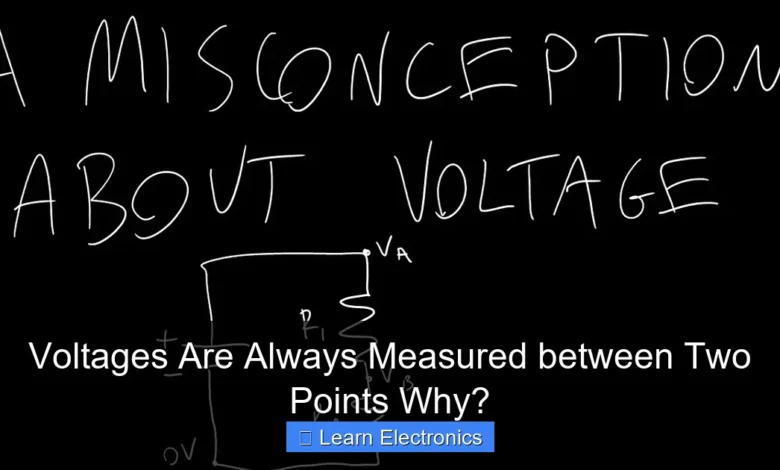Voltages Are Always Measured between Two Points Why?

Voltages Are Always Measured between Two Points Why? Because voltage, fundamentally, is a measure of the difference in electrical potential energy per unit charge between those two points, not an absolute value. This crucial concept underpins all electrical analysis.
Without two distinct points for comparison, the electrical potential difference, which voltage represents, is meaningless. This approach is critical for understanding circuit behavior, enabling current flow, and ensuring the correct operation of electronic systems.
Quick Answers to Common Questions
Why can’t I just measure voltage at one point?
Great question! You can’t measure voltage at just one point because voltage isn’t an absolute value of a single location; it’s the *difference* in electrical potential energy between two specific points. Think of it like comparing altitudes – you always need a reference, like sea level, to know a mountain’s true height.
So, what exactly *are* these “two points” when we talk about measuring voltage?
When we say “voltages are always measured between two points,” one point acts as your reference (often ground or a common return path), and the other is the specific location where you want to know the electrical potential difference relative to that reference. Your multimeter probes connect to each of these points.
Why is it so important that voltages are *always* measured between two points?
It’s super important because voltage represents the potential “push” or “pull” that drives current, and that only exists when there’s a difference in electrical potential. Without comparing two points, the measurement of voltage is meaningless, as there’s no comparative pressure to detect!
📑 Table of Contents
The Fundamental Nature of Electrical Potential Difference
In the realm of electronics, understanding voltage begins with grasping its true nature: it is a relative quantity. Unlike mass or temperature, which can be measured from an absolute zero point, voltage represents a “push” or “pull” force that can only be quantified by comparing two different states of electrical potential. Imagine trying to describe the steepness of a hill without mentioning both its top and bottom; it’s an incomplete picture. Similarly, electrical potential alone, at a single point, doesn’t tell us much about its ability to do work or drive current.
Analogy to Water Pressure
A common and helpful analogy is that of water pressure. If you have a water pipe, the pressure at any single point inside it doesn’t tell you whether water will flow or how forcefully it will flow. What truly matters is the pressure difference between two points — say, between a high-pressure source (like a water tower) and a lower-pressure outlet (like a faucet). Water flows from high pressure to low pressure, and the greater the difference, the stronger the flow. In an electrical circuit, voltage acts like this pressure difference, driving electrons (current) from a point of higher electrical potential to a point of lower electrical potential.
Relative Measurement and Energy Transfer
Electrical potential energy is stored in an electric field. When we speak of voltage, we’re talking about the potential energy difference per unit charge between two points in that field. It’s the work required or supplied to move a unit positive charge from one point to another. Because energy transfer always involves a “from” and a “to,” this necessity of a two-point measurement becomes intuitive. Electrons move from areas where they have more potential energy to areas where they have less, releasing energy in the process, which can then be harnessed to power devices. The value of this potential energy drop, or gain, is precisely what voltage quantifies.
Understanding Why Voltages Are Always Measured Between Two Points
The core reason this method of measurement is universal in electronics stems directly from the definition of voltage itself. Voltage (V) is formally defined as the work (W) done per unit charge (Q) to move that charge between two points: V = W/Q. This formula inherently requires two points for “work done” to have meaning. Work, in physics, is done when a force acts over a distance. In an electrical context, the electrostatic force acts on a charge as it moves from one potential to another.
The Concept of a Reference Point
To measure the potential difference accurately, one of the two points is often designated as a “reference point.” This reference is commonly referred to as “ground” or “common.” Ground is typically assigned a potential of zero volts. When you measure the voltage at a specific point in a circuit “with respect to ground,” you are inherently comparing its potential to that zero-volt reference. For instance, a 5-volt reading at a specific node means that node is 5 volts higher in potential than the designated ground point. Without a designated reference, any single point’s potential is arbitrary and unquantifiable in a meaningful way.
Practical Circuit Analysis
In practical circuit analysis, understanding why voltages are always measured between two points is crucial. If you want to know how much “push” is available across a resistor to drive current through it, you must measure the voltage on one side of the resistor and compare it to the voltage on the other side. This “voltage drop” across the component is what dissipates energy and determines the current flow according to Ohm’s Law. Measuring the voltage at just one terminal of the resistor, without reference to the other, would provide no useful information about its operation.
Tools and Techniques for Accurate Voltage Measurement
The design of measurement instruments, such as multimeters or oscilloscopes, inherently reflects the two-point requirement for voltage measurement. These devices come with at least two probes (typically red for positive and black for negative/ground) that must be connected to the two points across which the voltage is to be measured.
How a Voltmeter Works
A voltmeter is designed to measure potential difference and thus must be connected in parallel with the component or section of the circuit being measured. This means its two probes are placed across (in parallel with) the two points of interest. A voltmeter has a very high internal resistance, ensuring that it draws negligible current from the circuit and thus does not significantly alter the circuit’s operation while making its measurement. The instrument then calculates the potential difference by comparing the electrical state presented at its two input terminals.
Safety Considerations and Best Practices
- Probe Placement: Always connect the probes to the two specific points where you want to determine the potential difference.
- Circuit Power: Ensure the circuit is powered on for active voltage measurements.
- Range Selection: Start with a higher voltage range on your meter and then decrease it for more precise readings.
- Polarity: While modern digital voltmeters usually indicate negative readings if the probes are reversed, understanding polarity (red to higher potential, black to lower) is crucial for consistency and for working with older analog meters.
- Isolation: Never touch bare wires or probes when measuring live circuits.
Applications and Types of Voltage Measurements
The practice of measuring voltage between two points applies universally across all forms of electrical systems, from tiny integrated circuits to large power grids. Different types of measurements provide specific insights into circuit behavior.
DC vs. AC Voltage
For Direct Current (DC) circuits, voltage is typically constant over time, like that from a battery. Measurements are straightforward. For Alternating Current (AC) circuits, voltage constantly changes polarity and magnitude, like household electricity. AC voltage is usually measured as an RMS (Root Mean Square) value, which represents the effective voltage. Regardless of the type, both require two points for measurement: positive and negative terminals for DC, or two live terminals/a live and neutral for AC.
Voltage Drop and Kirchhoff’s Voltage Law
Voltage drop refers to the reduction in electrical potential along a conductor or across a component in a circuit. This is a classic example of a two-point measurement; you measure the potential at the start of the component and compare it to the potential at its end. Kirchhoff’s Voltage Law (KVL) states that the sum of all voltage drops around any closed loop in a circuit must equal zero. This law is entirely predicated on the concept of potential differences between defined points in the circuit, reinforcing the necessity of two-point measurements for circuit analysis.
Understanding Different Reference Points
While “ground” is a common reference, it’s not the only one. Sometimes, circuit designers will use “virtual grounds” or reference voltages other than zero. The principle remains the same: all voltage measurements are still relative to this chosen reference point. For example, in a dual-supply circuit, you might measure voltages relative to a positive rail, a negative rail, or a central ground point, depending on what insight you seek. The following table illustrates some common voltage measurement scenarios:
| Measurement Type | Points Measured Between | Typical Application |
|---|---|---|
| Source Voltage | Positive and Negative Terminals of a Battery/Supply | Checking power supply output |
| Voltage Drop | Across a Resistor, LED, or other Component | Determining current flow and power dissipation |
| Signal Voltage | Signal Line and Ground/Reference | Analyzing data or audio signals |
| Node Voltage | Specific Node and Circuit Ground | Understanding potential at various points in a complex circuit |
Common Misconceptions and Clarifications
One prevalent misconception among beginners is the idea of “absolute voltage” at a single point. This often stems from analogies that simplify electricity too much, failing to emphasize the comparative nature of voltage. Another is the belief that touching a single probe to a point will yield a meaningful reading, which it will not, as it lacks a reference.
Why a Single Probe is Insufficient
Without two points, a voltmeter cannot complete its internal circuit to measure the potential difference. The probes act as connection points, allowing a tiny, controlled current to flow through the meter’s internal resistance, which is then used to calculate the voltage. If only one probe is connected, no current can flow through the meter, and therefore, no measurement can be made. This is why you always need to connect both probes to distinct points in the circuit.
Voltage is Not a “Charge” Measurement
While voltage is related to electrical charge, it is not a direct measurement of charge itself. Charge (measured in Coulombs) is the fundamental property of matter that experiences an electrical force. Voltage, on the other hand, is a measure of the potential energy that unit charge possesses due to its position in an electric field. Think of it as the “potential” or “pressure” that drives charge, rather than the amount of charge present. This distinction is vital for a clear understanding of electronics.
In conclusion, the practice of always measuring voltage between two points is not an arbitrary rule but a fundamental principle derived from the very definition of voltage as a difference in electrical potential. This two-point measurement provides the necessary context to quantify the electrical “push” that drives current, enables energy transfer, and dictates the behavior of all electronic circuits. By understanding this core concept, electronics enthusiasts and professionals alike can effectively analyze, troubleshoot, and design electrical systems with confidence and precision.
Frequently Asked Questions
Why is it necessary to always measure voltage between two points?
Voltage is fundamentally defined as the difference in electrical potential energy between two distinct locations in an electric field or circuit. Measuring it requires comparing the potential at one point against the potential at another, establishing this critical difference. Without two points, there is no “difference” to quantify, only a potential relative to an unstated or implicit reference.
What happens if I attempt to measure voltage with only one probe?
If you only use a single probe with a voltmeter, you won’t get a meaningful voltage reading because the measurement circuit isn’t complete. A voltmeter requires both probes to establish a path and detect the potential difference between the points where they are connected. The second probe provides the necessary reference point for the measurement to be valid.
Can a point in a circuit have “voltage” without a second reference?
A single point in a circuit possesses an “electrical potential” relative to an agreed-upon zero potential, such as earth ground. However, voltage itself is strictly defined as the *difference* between the potentials of two points. Therefore, while a point has potential, the measurable quantity of “voltage” always requires two points to establish that difference.
Why is a “reference point” so crucial for a voltage measurement?
A reference point is vital because it provides the baseline or zero potential against which another point’s potential is compared. All voltage measurements are relative; they tell you how much higher or lower the electrical potential is at one point compared to the chosen reference. Without a consistent reference, any measurement would be arbitrary and lack practical meaning.



